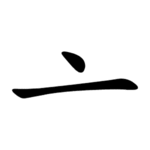Radical 8
| 亠 | ||
|---|---|---|
| ||
| 亠 (U+4EA0) "lid, head" | ||
| Pronunciations | ||
| Pinyin: | 頭 tóu | |
| Bopomofo: | ㄊㄡˊ | |
| Gwoyeu Romatzyh: | tour | |
| Wade–Giles: | tʻou2 | |
| Cantonese Yale: | tàuh | |
| Jyutping: | tau4 | |
| Pe̍h-ōe-jī: | thâu (col.) thô͘ (lit.) | |
| Japanese Kana: | なべぶた nabebuta | |
| Sino-Korean: | 두 do | |
| Names | ||
| Japanese name(s): | 鍋蓋 nabebuta | |
| Hangul: | 자의미상 jauimisang | |
| Stroke order animation | ||
 | ||
Radical 8 meaning "lid" is one of 23 of the 214 Kangxi radicals that are composed of 2 strokes.
In the Kangxi Dictionary there are 38 characters (out of 40,000) to be found under this radical.
Characters with Radical 8
| strokes | character | |
|---|---|---|
| without additional strokes | 亠 | |
| 1 additional stroke | 亡 | |
| 2 additional strokes | 六 卞 亢 亣 | |
| 4 additional strokes | 交 亥 亦 产(簡軆) | |
| 5 additional strokes | 亨 亩 亪 | |
| 6 additional strokes | 享 京 | |
| 7 additional strokes | 亭 亮 亯 亰 亱 亲 | |
| 8 additional strokes | 亳 | |
| 10 additional strokes | 亴 亵 | |
| 11 additional strokes | 亶 亷 | |
| 14 additional strokes | 亸(簡軆) | |
| 19 additional strokes | 亹 |
There is a difference in Japanese and Chinese in printing typefaces for this radical. In the Kangxi Dictionary and in Japanese, a short vertical line on top of the horizontal line is used. In China, Taiwan, and Hong Kong, a slanted dash, or Radical 3, on top of the horizontal line is also used.
| Kangxi Dictionary Japan Korea |
China Taiwan Hong Kong |
|---|---|
| 亠 | 亠 |
Literature
- Fazzioli, Edoardo (1987). Chinese calligraphy : from pictograph to ideogram : the history of 214 essential Chinese/Japanese characters. calligraphy by Rebecca Hon Ko. New York: Abbeville Press. ISBN 0-89659-774-1.
- Leyi Li: “Tracing the Roots of Chinese Characters: 500 Cases”. Beijing 1993, ISBN 978-7-5619-0204-2
External links
See also
Wikimedia Commons has media related to Radical 008.
